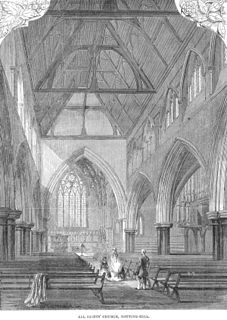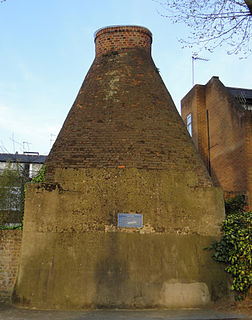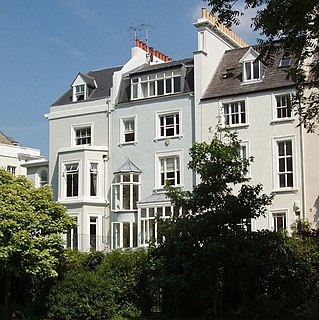
The Royal Borough of Kensington and Chelsea is an Inner London borough with royal status. It is the smallest borough in London and the second smallest district in England; it is one of the most densely populated administrative regions in the United Kingdom. It includes affluent areas such as Notting Hill, Kensington, South Kensington, Chelsea, and Knightsbridge.

Notting Hill is a district of West London, England, in the Royal Borough of Kensington and Chelsea. Notting Hill is known for being a cosmopolitan and multicultural neighbourhood, hosting the annual Notting Hill Carnival and Portobello Road Market. From around 1870, Notting Hill had an association with artists.

Notting Hill Gate is one of the main thoroughfares of Notting Hill, in the Royal Borough of Kensington and Chelsea. Historically the street was a location for toll gates, from which it derives its modern name.

Perec "Peter" Rachman was a Polish-born landlord who operated in Notting Hill, London, England in the 1950s and early 1960s. He became notorious for his exploitation of his tenants, with the word "Rachmanism" entering the Oxford English Dictionary as a synonym for the exploitation and intimidation of tenants.

Regent's Park and Kensington North was a constituency in Central and West London represented in the House of Commons of the Parliament of the United Kingdom. It elected one Member of Parliament (MP) by the first past the post system of election.

Kensington is a constituency in Greater London which first existed between 1974 and 1997 and was recreated in 2010. Since 2019, it has been represented in the House of Commons of the UK Parliament by Felicity Buchan of the Conservative Party.

North Kensington is an area of west London. It is north of Notting Hill and south of Kensal Green and in the Royal Borough of Kensington and Chelsea. The names North Kensington and Ladbroke Grove describe the same area.

Roy Stewart was a Jamaican-born British actor. He began his career as a stuntman and went on to work in film and television.

Pinehurst Court is a portered Victorian mansion block at 1-9 Colville Gardens, just off Colville Terrace and near the Portobello Market in Notting Hill, London, England. The terrace was initially built in the 1870s by the builder George Frederick Tippett, as single family residences, but from the 1880s the houses began to be subdivided into flats. By 1928 the neighbourhood was described as "rapidly becoming poorer", and by 1935 as a "largely slum area". The gentrification of Notting Hill in the 1980s and 1980s greatly improved the character of the building, which now forms a part of one of London's most fashionable neighbourhoods.

The Tabernacle is a Grade II-listed building in Powis Square, Notting Hill, west London, England, built in 1887 as a church. The building boasts a curved Romanesque façade of red brick and terracotta, and towers with broach spires on either side. Today the Tabernacle serves as a cultural arts and entertainment venue, including a theatre, meeting rooms, music studio, art gallery, bar and kitchen, conservatory and a garden courtyard.

All Saints Notting Hill is a Church of England parish church in Talbot Road, Notting Hill, London. It is a Victorian Gothic Revival stone building with polychromatic decoration. The west tower has five stages with the stump of a spire, and the chancel has paintings by Henry Holiday.

The Royal Crescent is a Grade II* listed street in Holland Park, west London, England, consisting of two curved facing terraces in a crescent shape. The crescent is located on the north side of Holland Park Avenue, west of Addison Avenue, and to the east of the Holland Park Roundabout.

Colville Gardens is a Victorian cul-de-sac street in the Royal Borough of Kensington and Chelsea, located north of Colville Terrace and east of the Portobello Market in Notting Hill, London, England. It is bordered on the north side by All Saints' Church.

Pottery Lane is a street in Notting Hill, west London. Today it forms part of one of London's most fashionable and expensive neighbourhoods, but in the mid-19th century it lay at the heart of a wretched and notorious slum known as the "Potteries and the Piggeries". The slum came to the attention of Londoners with the building of the Hippodrome in 1837 by entrepreneur John Whyte. Unfortunately for Whyte a public right of way existed over his land and "dirty and dissolute vagabonds" from the nearby slum invaded his racecourse, adding to his financial difficulties and, in part, leading to the closure of his venture in 1842. Pottery Lane gradually improved in the late 20th century along with the rest of the Notting Hill area, and today the houses there fetch multi-million pound prices. Just one of the original brick kilns still survives; it is located in Walmer Road, just north of Pottery Lane, and bears a commemorative plaque placed there by the Royal Borough of Kensington and Chelsea.

Rhaune Laslett was a community activist and the principal organiser of the Notting Hill Fayre or Festival, that evolved into the Notting Hill Carnival.

Ladbroke Square is a garden square in Notting Hill, west London, England.

Emslie Horniman's Pleasance is a park in the Borough of Kensington and Chelsea in London. Named after the London County Councillor Emslie John Horniman who created it, and opened in 1914. It is the traditional starting point for the Notting Hill Carnival.

Golborne Road is a street in the Royal Borough of Kensington and Chelsea in London's Kensal Town. The road runs east from Portobello Road to Kensal Road.

Blenheim Crescent is a street in the Ladbroke Estate area of the Notting Hill district of west London.




















